Ecosystem Services
The Millennium Ecosystem Assessment (Box 2.1) identified several categories of ecosystem services:
Provisioning services are the goods or products obtained from ecosystems such as food, freshwater, timber, and fiber. These services are tangible and many—but not all—are often tradable and priced in the marketplace.
Regulating services are the benefits obtained from an ecosystem’s control of natural processes such as climate, erosion, water flows, and pollination. Currently, forest landowners typically do not receive payments or compensation for providing these services.
Cultural services are the nonmaterial benefits obtained from an ecosystem such as recreation, aesthetic enjoyment, and spiritual renewal.
Supporting services are natural processes—such as nutrient cycling, primary production, and water cycling—that maintain the other ecosystem services. [Since supporting services benefit people not directly but rather through the other types of ecosystem services, this publication does not further discuss supporting services.]
 Source: Millennium Ecosystem Assessment 2005.
Source: Millennium Ecosystem Assessment 2005.Southern forests provide a variety of these services (Table 2.1). Beneficiaries are located at the local, regional, and/or global scale and include future generations. For instance, southern forests provide local people with fuelwood and hunting opportunities. At a regional level, they filter water and offer recreation for urban and rural dwellers. At a global level, they sequester carbon—helping to regulate greenhouse gas concentrations in the atmosphere—and provide wood for the global forest products industry.
Provisioning services
Southern forests provide a wide range of provisioning services including timber, pulpwood for paper, biomass fuel, and a number of non-timber forest products.
Timber and pulpwood
Many southern forests are “working forests” in that they are actively managed to yield timber and pulpwood. Southern yellow pines are popular for construction lumber. Furniture and cabinet makers use oak, hickory, and beech, among other species. Oak is common for hardwood flooring, and is also used for wood veneer, trim, millwork, plywood, and pallets. Manufacturers convert a variety of softwood and hardwood species to pulp for making cardboard, office paper, tissue, and other paper products.
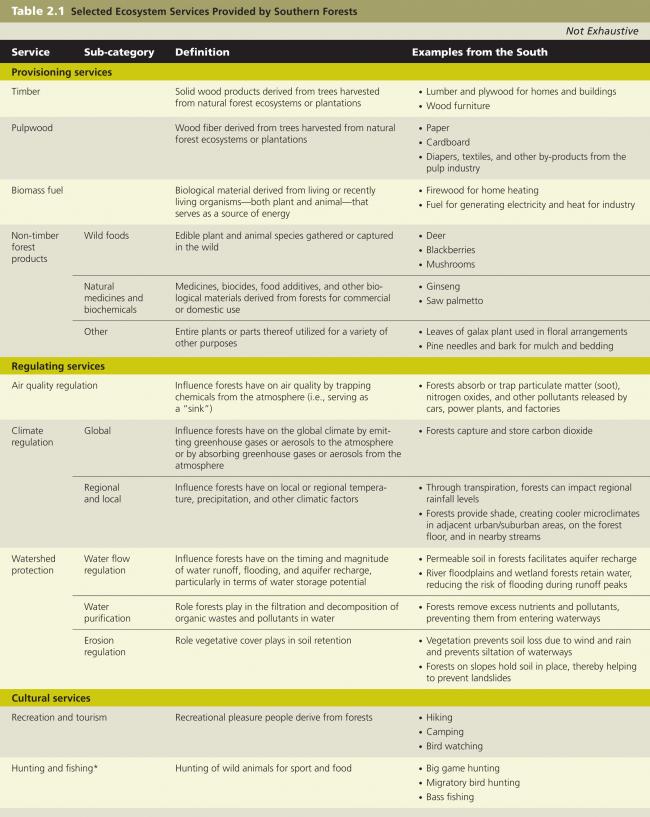 *Hunting and fishing can be considered a provisioning service, too, in that these activities yield wild food.
Source: Adapted by the World Resources Institute from the Millennium Ecosystem Assessment, 2005.
*Hunting and fishing can be considered a provisioning service, too, in that these activities yield wild food.
Source: Adapted by the World Resources Institute from the Millennium Ecosystem Assessment, 2005.Although they comprise just 2 percent of the planet’s total forest cover, southern forests are disproportionately productive. They generate 18 percent of the world’s pulpwood for paper and paper-related products and 7 percent of its industrial roundwood. The region yielded 8.6 billion cubic feet of wood in 2006.
Accordingly, the South is the nation’s “wood basket” (Figure 2.1). The region’s share of the U.S. wood harvest has grown over the past half century, increasing from 46 percent in 1952 to 57 percent in 2006 (Figure 2.2).1 This growth has been due to increased southern forest inventories via natural regeneration and tree planting efforts, strong market demand that encouraged forests to be managed for timber and pulp, new technologies that allowed for a wider variety of species to be utilized, and public policies that reduced harvesting from public lands in the western United States.2
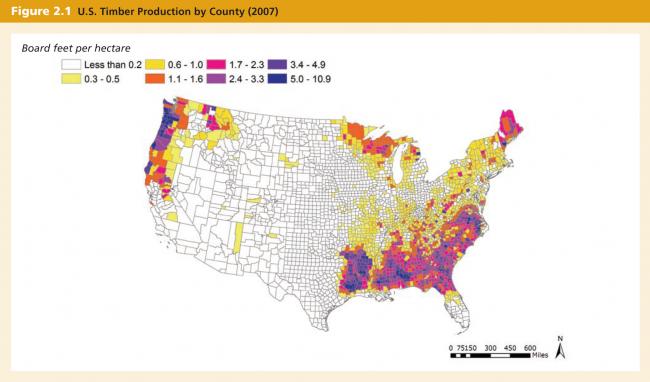 Source: WRI analysis of national timber production (Johnson et al. 2009) and administrative boundaries (ESRI Data and Maps 9.3.1, ESRI 2008).
Note: 1 hectare = 2.47 acres
Source: WRI analysis of national timber production (Johnson et al. 2009) and administrative boundaries (ESRI Data and Maps 9.3.1, ESRI 2008).
Note: 1 hectare = 2.47 acres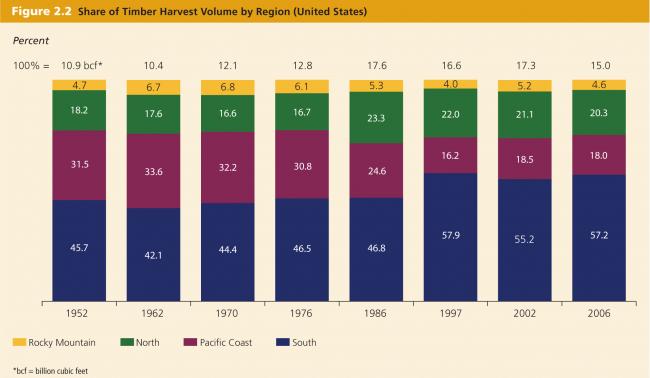 *bcf = billion cubic feet
Source: WRI analysis from data in Haynes et al. 2007 and Smith et al. 2009.
Note: Figures may not add to 100 due to rounding.
*bcf = billion cubic feet
Source: WRI analysis from data in Haynes et al. 2007 and Smith et al. 2009.
Note: Figures may not add to 100 due to rounding.Wood supplied by southern forests generates significant economic benefits in the South, particularly for more rural communities, at both the harvesting and manufacturing stages. In 2007, the value of sawtimber, veneer logs, poles, and pulpwood harvested from southern forests was nearly $12 billion. The regional economic impact of this harvest approached $30 billion when taking multiplier effects into account. Direct timber harvesting activities generated nearly 600,000 jobs, as well as indirect and induced spending by businesses and households.
Biomass fuel
Trees, wood, and wood residues from southern forests provide energy for families and businesses in the region. Many southern households burn cordwood in fireplaces or stoves to generate heat. Companies—particularly those in the forest products industry—burn wood chips, sawdust, bark, lignin, and other wood processing residues to generate heat and/or electricity for their manufacturing operations. Depending on technological developments for converting wood fiber into liquid sources of energy, forests might also provide feedstocks for liquid biofuels for transportation applications in the future.
In 2007, more than 300 million cubic feet of domestic fuelwood—just a portion of total biomass fuel generated—was harvested from southern forests, which is equivalent to roughly 2.5 million cords. The value of this domestic fuelwood harvest was approximately $188 - $375 million.3
Non-timber forest products
Southern forests supply a range of products besides timber, pulpwood, and biomass fuel. These goods—often called “non-timber forest products”—have a variety of uses such as food, arts and crafts, medicinal and dietary supplements, floral and decorative applications, and landscape products. More than 10 percent of southern landowners harvested non-timber forest products from their land between 2001 and 2006. Examples from southern forests include:
- 20 species of edible plants such as blackberries, muscadine grapes, and wild onions, as well as edible fungi such as morel and wood ear mushrooms;
- More than 200 species of floral, decorative, and landscaping plants such as southern magnolia, rhododendron, and azalea;
- Wood chips and pine needles for mulch and bedding; and
- Over 125 species of medicinal and dietary supplements, including saw palmetto, black cohosh, and ginseng —with 80 percent of the global ginseng harvest coming from Kentucky, Virginia, Tennessee, and North Carolina.
Non-timber forest products contribute more than $1 billion annually to the South’s economy.4
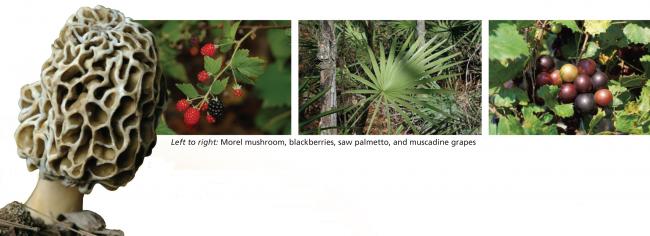
Regulating services
Southern forests play an important role in naturally regulating air quality, global climate, regional and local climate, water flows, water purity, and erosion.
Air quality regulation
Southern forests play a role in improving local and regional air quality. Trees can absorb or trap nitrogen dioxide, sulfur dioxide, and particulate matter 10 microns or less in size5 — pollutants that can induce asthma or other respiratory problems — emitted by factories, power plants, and automobiles. According to one study in 2002, forests in the Charlottesville, Virginia area remove approximately 43 pounds of these and other air pollutants per acre per year.6 The economic value of this airborne pollution removal is estimated to be $261 per acre of forest per year.7 Another study estimated that forests around Atlanta remove approximately 80–90 pounds of air pollutants per acre per year, at an estimated economic value of $205–$230 per acre per year. Similarly, the estimated economic value of airborne pollution removal by the tree canopy in the city of Miami, Florida is $287 per acre per year.8 Rates of airborne pollution removal vary based on the pollutant type, leaf season length, and precipitation levels.
Global climate regulation
Forest ecosystems help regulate earth’s climate—its long-term temperature, precipitation patterns, and other meteorological phenomena—by playing a role in the global carbon cycle. The carbon cycle influences global climate because atmospheric carbon, in the form of carbon dioxide, is the leading greenhouse gas. Greenhouse gases trap heat leaving the earth’s surface, creating a “blanket” that warms the earth’s atmosphere. Scientists, policymakers, and others are currently concerned that the marked buildup of greenhouse gas concentrations in the atmosphere—primarily through human activities since the industrial revolution—is contributing to long-term changes in the planet’s climate that is above and beyond natural climatic variations.9
Forests are major repositories or “sinks” of carbon (Figure 2.3). Trees absorb carbon dioxide during the process of photosynthesis. Some of this carbon becomes stored or “sequestered” in branches, trunks, and roots, while some becomes stored in soils when leaves and other parts of trees decay (Figure 2.4). By sequestering carbon, a standing forest removes carbon dioxide from the atmosphere and thereby helps prevent the buildup of greenhouse gases. Conversely, converting or degrading forests has the opposite effect. As forests degrade and disappear, the size of nature’s terrestrial vegetative carbon sink shrinks.
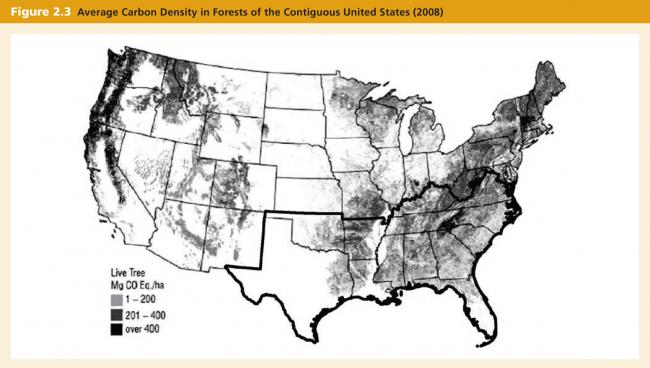 Source: U.S. Environmental Protection Agency (EPA) 2009.
Note: This graphic shows county-average carbon densities for live trees on forest land, including both above- and belowground biomass. These data are based on the most recent forest
inventory survey in each state.
Source: U.S. Environmental Protection Agency (EPA) 2009.
Note: This graphic shows county-average carbon densities for live trees on forest land, including both above- and belowground biomass. These data are based on the most recent forest
inventory survey in each state.Southern forests play an important role in global climate regulation. In 2007, U.S. forests absorbed an estimated 910 million metric tons of carbon dioxide equivalent, an amount equal to approximately 13 percent of the country’s gross greenhouse gas emissions from industrial and other sources. In recent years, southern forests—which comprise about 29 percent of U.S. forest cover—have accounted for approximately one-third of the annual carbon sequestered by U.S. forests.10
Regional and local climate regulation
Southern forests can influence local and regional climate. By providing shade, forests reduce air temperatures and create cooler microclimates under the canopy. Forest interiors, for instance, are on average lower in temperature than nearby open fields. Forest canopies in urban areas block incoming sunlight, thereby serving as natural air conditioners. In fact, annual energy costs for a shaded house can be 20–25 percent lower than that of the same house without trees.11
Trees also can create microclimates in bodies of water. Forest canopies can provide shade for streams and lakes, creating cooler pools of water relative to unshaded stretches. Cool water holds more oxygen, supports beneficial algae, and serves as important habitat for trout, crayfish, and the larva of invertebrates such as mayflies and caddisflies.
Water flow regulation
Forests and forested wetlands affect the timing and magnitude of water runoff and water flows. Some forest ecosystems act as sponges, intercepting rainfall and absorbing water through root systems. Water is stored in porous forest soils and debris, and then is slowly released into surface waters and groundwater. Through these processes, forests recharge groundwater supplies, maintain baseflow stream levels, and lower peak flows during heavy rainfall or flood events. The ability of forests to absorb and store runoff can be approximately 20 times greater than that of an impervious parking lot and nearly six times greater than a residential lawn.12
The water flow regulation services that forests provide can yield economic benefits to communities. By reducing water runoff during rainstorms, forests reduce the volume of water that a municipal stormwater containment facility or retention pond must store. Communities, therefore, do not need to invest as much in constructing stormwater control infrastructure. Based on this avoided cost of stormwater storage, one assessment estimated that forests near Atlanta saved the city $420 per acre per year.13
Water purification
Two-thirds of the nation’s clean water supply comes from precipitation that is filtered through forests and ends up in streams.14 Forests help prevent impurities—mostly from nonpoint source pollution —from entering streams, lakes, and groundwater in a number of ways. Root systems of trees and other plants keep soils porous and allow water to filter through various layers of soil before entering groundwater. Through this process, toxins, nutrients, sediment, and other substances can be filtered from the water. Leaves and other debris on the forest floor play a role, too. Through the process of denitrification, for example, bacteria in wet forest soils convert nitrates—a nutrient that can lead to harmful algal blooms if too much of it enters bodies of water—into nitrogen gas, releasing it into the air instead of into local streams.15
The water purification benefits of forests are economically valuable. Studies conducted by the American Water Works Association and the Trust for Public Land concluded that drinking water treatment costs decrease as the amount of forest cover in the relevant watershed increases (Figure 2.5). They found that 50–55 percent of the variation in operating treatment costs could be explained by percentage of forest cover in the water source area.16
Erosion regulation
Southern forests help keep soil intact and prevent it from eroding into nearby bodies of water in a number of ways. By intercepting rain, a forest canopy reduces the impact of heavy rainfall on the forest floor, reducing soil disturbance. Leaves and natural debris on the forest floor can slow the rate of water runoff and trap soil washing away from nearby fields. Tree roots can hold soil in place and stabilize stream banks. In addition, coastal forests and forested wetlands protect coastlines by absorbing some of the energy and impact of storm surges, thus reducing erosion and other on-shore impacts.
This erosion control provides a number of benefits to people. For instance, it can help reduce the deposition of sediment behind hydroelectric dams — the Tennessee Valley Authority alone has 30 dams17 — and thereby reduce the need for expensive dredging.
Cultural services
Southern forests provide several cultural ecosystem services, including tourism, outdoor recreation, hunting, and fishing.
Recreation and tourism
Southern forests provide a setting for a range of recreational activities, including hiking, camping, mountain biking, and viewing wildlife. People also fish, canoe, and raft in the many lakes and rivers located in southern forests. Participation in these and other forms of outdoor recreation has been growing in the South (Figure 2.6).
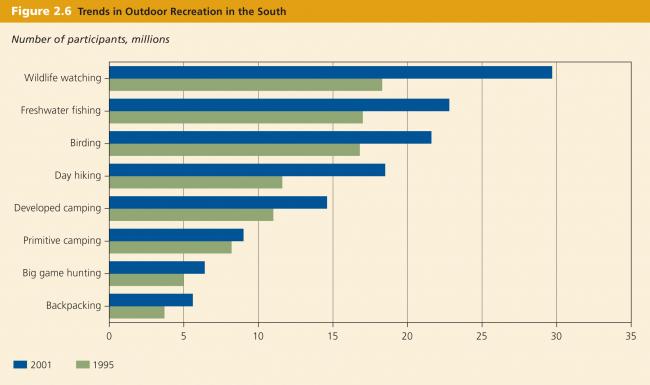 Source: Wear and Greis 2002.
Source: Wear and Greis 2002.Of the nation’s forests, those of the South are among the most popular recreation destinations. For instance, federally owned forests in the South are the third most heavily used of the nine U.S. Forest Service regions, with 25.8 million visitors in 2007.18 Great Smoky Mountains National Park—located in the heart of the southern forest—is the most frequently visited national park in the United States, with over 9 million recreational visitors in 2008.
Estimates vary widely regarding the economic contribution of recreation and tourism associated with southern forests. The U.S. Forest Service calculates that southern forests underpin an estimated $19 billion to $76 billion per year in recreational and tourism revenue. Likewise, southern forests support 250,000 to 1.15 million recreation- and tourism-related jobs in the region.19
Hunting and fishing
Many people hunt and fish in southern forests and adjacent areas. In 2000, more than 6 million people went hunting in the South for big game such as white tail deer, nearly 6 million people hunted for small game such as rabbit, and 2 million hunted for migratory birds such as ducks. In addition, nearly 23 million people that year went fishing in the freshwaters of the South.20 Popular recreational fishing species include bass, catfish, and crappie.
These cultural services make a significant contribution to the region’s economy. Expenditures on hunting, fishing, and wildlife-watching activities in the South were an estimated $41.4 billion in 2006. This amount accounted for 34 percent of total U.S. expenditures on wildlife-associated recreation. Spring turkey hunting alone generated $1.8 billion in sales and related economic activity and supported 17,000 full- and part-time jobs in the South in 2003.21
-
Prestemon, Jeffrey P., and Robert C. Abt. 2002. “Timber Products Supply and Demand.” In Wear, David N., and John G. Greis, eds. Southern Forest Resource Assessment. Gen. Tech. Rep. SRS-53. Asheville, NC: U.S. Department of Agriculture, Forest Service, Southern Research Station. ↩
-
Wear, D.N. and J.G. Greis. 2002b. The Southern Forest Resource Assessment: Summary Report. Gen. Tech. Rep. SRS-54. Asheville, NC: U.S. Department of Agriculture, Forest Service, Southern Research Station. ↩
-
Johnson, T.G., J.W. Bentley, and M. Howell. 2006. The south’s timber industry—an assessment of timber product output and use, 2003. Asheville, NC: U.S.D.A. Forest Service Southern Research Station. ↩
-
Harper, R.A. 2005. “Report Card: A Look at Several Indicators on Sustainability in the South.” Presentation to the Southern Roundtable on Sustainable Forests, fall conference, Asheville, NC, September 2005. U.S. Department of Agriculture, Forest Service, Southern Research Station. ↩
-
American Forests. 2002a. 2002 Regional Economic Analysis Chesapeake Bay Watershed-Charlottesville, VA and Harrisburg, PA Areas. Calculating the Value of Nature. Washington, DC: American Forests. ↩
-
American Forests. 2002a. 2002 Regional Economic Analysis Chesapeake Bay Watershed-Charlottesville, VA and Harrisburg, PA Areas. Calculating the Value of Nature. Washington, DC: American Forests. ↩
-
American Forests. 2002b. Projected Environmental Benefits of Community Tree Planting: A Multi-Site Model Urban Forest Project in Atlanta. Washington, DC: American Forests. ↩
-
American Forests. 2008. Urban Ecosystem Analysis: Miami-Dade County, UDB and the City of Miami, Florida. Calculating the Value of Nature. Washington, DC: American Forests. ↩
-
IPCC, 2007. Climate Change 2007: The Physical Science Basis. Contribution of Working Group I to the Fourth Assessment Report of the Intergovernmental Panel on Climate Change [Solomon, S., D. Qin, M. Manning, Z. Chen, M. marquis, K.B. Averyt, M. Tignor and H.L. Miller (eds.)]. Cambridge University Press, Cambridge, United Kingdom and New York, NY, USA, 966 pp. ↩
-
Jose, S. 2007. “Carbon Sequestration and Intensive Silviculture: The Southern U.S. Experience.” Paper presented to the American Geophysical Union, Fall Meeting 2007 (abstract #B53A-03). ↩
-
Heisler, G.M. 1986. “Energy Savings with Trees.” Journal of Arboriculture 12 (5): 113–25. ↩
-
Cappeilla, K., T. Schueler, and T. Wright. 2005. Urban Watershed Forestry Manual, Part 1: Methods for Increasing Forest Cover in a Watershed. NA-TP-04-05. 94. Ellicott City, MD: USDA Forest Service. ↩
-
American Forests. 2001. Urban Ecosystem Analysis Atlanta Metro Area: Calculating the Value of Nature. Washington, DC: American Forests. ↩
-
Smail, Robert A., and David J. Lewis. 2009. “Forest Land Conversion, Ecosystem Services, and Economic Issues for Policy: A Review.” PNW-GTR-797. Portland, OR: U.S. Department of Agriculture, Forest Service, Pacific Northwest Research Station. ↩
-
Sprague, E. et al., eds. 2006. The State of Chesapeake Forests. Arlington, VA: The Conservation Fund. ↩
-
Ernst, C. 2004. Protecting the Source: Land Conservation and the Future of America’s Drinking Water. Water Protection Series. San Francisco, CA: The Trust for Public Land and American Water Works Association. ↩
-
Tennessee Valley Authority. 2003. “Dams and Hydro Plants.” ↩
-
USDA Forest Service. 2008. “National Visitor Use Monitoring Results: National Summary Report.” ↩
-
Abt, Karen L., Susan A. Winter, and Robert J. Hugget, Jr. 2002. “Local Economic Impacts of Forests.” In Wear, David N., and John G. Greis, eds. 2002. Southern Forest Resource Assessment. Gen. Tech. Rep. SRS-53. Asheville, NC: U.S. Department of Agriculture, Forest Service, Southern Research Station. ↩
-
Abt, Karen L., Susan A. Winter, and Robert J. Hugget, Jr. 2002. “Local Economic Impacts of Forests.” In Wear, David N., and John G. Greis, eds. 2002. Southern Forest Resource Assessment. Gen. Tech. Rep. SRS-53. Asheville, NC: U.S. Department of Agriculture, Forest Service, Southern Research Station. ↩
-
Southwick Associates, Inc. 2003. “The 2003 Economic Contributions of Spring Turkey Hunting.” Fernandina Beach, FL: The National Wild Turkey Federation. ↩



